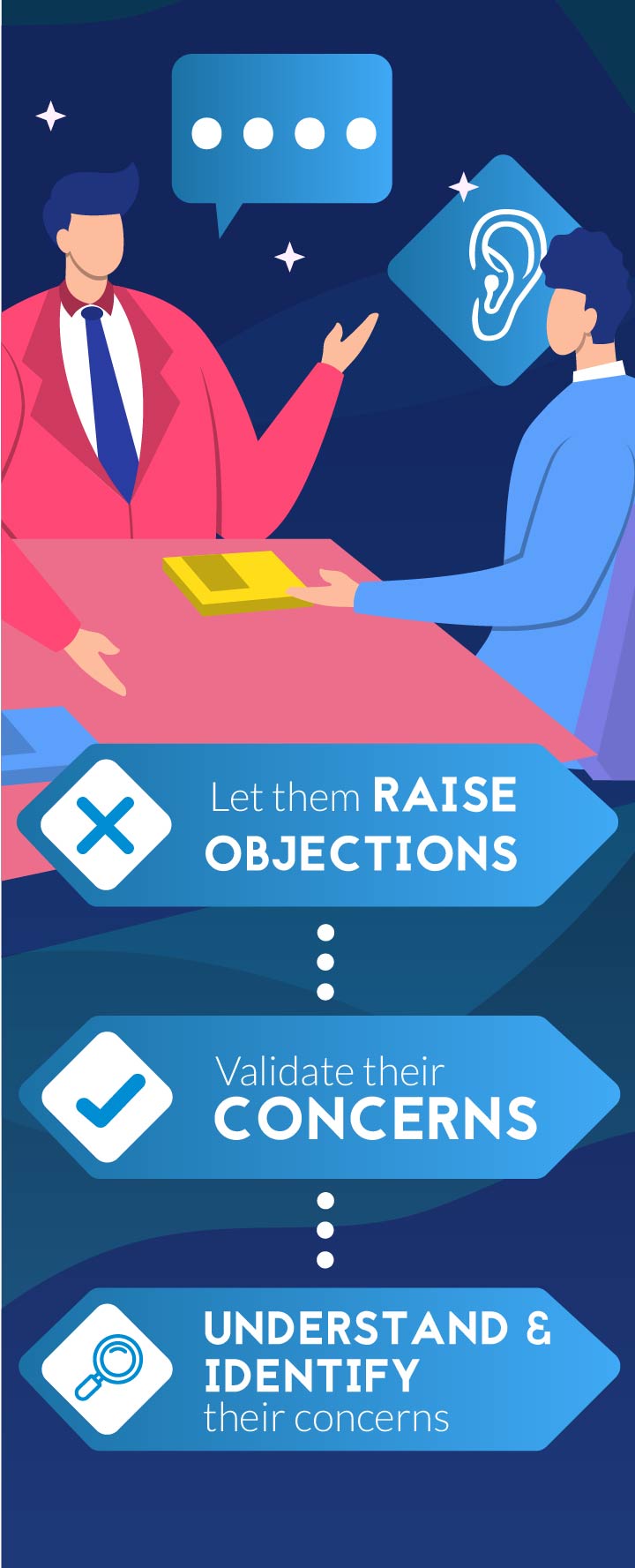
Objections are an inevitable part of the sales process.
As a sales professional, it is a part of the job that you will have to manage. The way you handle objections during sales can be the difference between closing a sale and losing a customer. Managing these objections is a key skill to learn. Therefore, in this blog, we’ll explore how to handle objections in sales, provide examples of objection handling methods, and outline a step-by-step objection handling process.
Methods of Handling Customer Objections
1. Listen Actively
Active listening is a very valuable skill that can take time to develop. A sale should feel like a conversation, with a natural give and take. A lecture is not engaging, and does not show the customer that their time is important.
- Let the customer raise their objections: If a customer has a concern, listen carefully to what they say. Consider their words before you make an attempt to continue the sale.
- Validate their concerns: Interrupting or dismissing a customer’s objections can make the customer feel like they are not being heard. Validate their perspective by demonstrating empathy towards their concerns.
- Understand and identify their concerns: Active listening allows you to find the root of their objection. By identifying the root of their concern, you can work to identify solutions to address their concern without downplaying it.


2. Clarify the objection
After listening to the customer’s objection, it is important to make sure that you understand it properly. You have listened actively, and now you will respond in kind.
- Start by clarifying the concern with open-ended questions:
- “Can you tell me more about why you feel that way?”
-
- “What specifically is holding you back from moving forward?”
- By giving the customer more room to speak, it is easier to identify the best way to move forward in the objection handling process.
3. Reframe the objection
By clarifying the objection it is easier to respond in kind. The information given by the customer allows you to follow up with a response that reframes the objection in a different way.
- Objections can sometimes be based on a misunderstanding or misperception. In that case, reframing the objection in a different way can clear up any confusion quickly.
- A misunderstanding should be fixed quickly. Reframe the objection with additional information, or a different perspective to help the customer. By doing so, you have shown active listening, and responded with a solution through reframing the information.
4. Address the objection directly
Not all objections a customer brings up will come from a misunderstanding. If reframing the concern is not applicable, one of the best methods of handling customer objections is just to address the objection directly.
- Objections can sometimes be a result of real concern or challenges. These concerns may be directed towards your product, or brought in with the customer.
- Address the objection directly. An objection should not be left until later. Provide a solution through what your product offers and how their concern can be handled.
5. Overcome objections with social proof
Some customers may be concerned with how well your product or service works. Especially if the customer is new to what your company offers. Social proof can show the customer that you are worth trusting, and a credible source.
- What social proof is: Social proof can be customer testimonials, case studies, or industry awards. It serves as a strong way to overcome objections, as it shows clear use of your product or service.
- What social proof offers: Offering social proof shows that your company has been successful. By demonstrating that others have supported your product or service you can better build credibility and trust with the company.
6. Ask for the sale
You have handled the customer’s objections, provided solutions, and hopefully overcome the objections they have brought up. It is now the final part of the objection handling process.
- Asking for the sale should be one of the last methods of handling customer objections, because the objections should be addressed by now. If you have not cleared the sale, it is important to ask for the sale. If you do not ask, they may not settle the sale when they leave.
- Show that you are confident, and be direct in the sale. Use the credibility and trust you have established during the sale, while respecting the customer.
How to Handle Objections in Sales Examples
“I’m not interested.”
- Objection handling method: Reframe the objection.
Response: “I understand that you may not be interested right now, but let me explain how our product can benefit you. Our product has helped many customers in your industry reduce costs and increase efficiency. Would you be open to hearing more about how we can help you achieve similar results?”
“Your product is too expensive.”
- Objection handling method: Address the objection directly.
Response: “I understand that price is a concern for you. However, our product has a proven track record of delivering a high ROI for our customers. By using our product, you can reduce your overall costs and increase your revenue. Would you be open to exploring how our product can help you achieve these results?”
“I’m not familiar with your company.”
- Objection handling method: Overcome objections with social proof.
Response: “Oh, that’s no problem at all. I would love to share some testimonials with you from customers who highly recommend our product. In fact, our company just recently won an [Industry Award] for our service. I understand that trusting an unfamiliar company can be scary, but would you be open to reading a few customer testimonials?”
“I need to think about it.”
- Objection handling method: Ask for the sale.
Response: “I completely understand that this is a big decision. However, I believe that our product is the best solution for your needs. Can I answer any additional questions or concerns you may have? If not, are you ready to move forward with the purchase today?”
How iDecide Empowers Sales Reps to Handle Objections Effectively
You deserve to feel in charge of your sales. Making a successful sale happen can be hard, but there are a great number of tools that can make that process easier. Naturally, you should have a top-of-the-line presentation software like iDecide!
- iDecide allows your sales reps to create customized presentations that are tailored to your needs and interests. Powerpoints are a relic of the past, it’s time for you to engage your customers properly.
- When faced with objections during a sales presentation, your sales rep can use the interactive elements of our software to address the objection immediately.
- iDecide’s interactive presentation software also allows sales reps to gather feedback in real-time. Identify objections early and address them before they become a major obstacle.
- Finally, the presentation software provides analytics and insights that can help sales reps identify patterns in objections and fine-tune their methods of handling customer objections over time.
